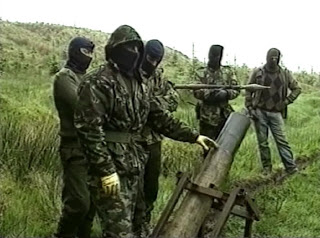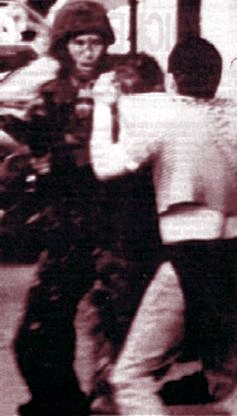
The East Tyrone Brigade of the Provisional Irish Republican Army (IRA), also known as the Tyrone/Monaghan Brigade was one of the most active republican paramilitary groups in Northern Ireland during "the Troubles". It is believed to have drawn its membership from across the eastern side of County Tyrone as well as north County Monaghan and south County Londonderry.
This is a chronology of activities by the Provisional Irish Republican Army (IRA) from 1970 to 1979.

From 1969 until 1997, the Provisional Irish Republican Army (IRA) conducted an armed paramilitary campaign primarily in Northern Ireland and England, aimed at ending British rule in Northern Ireland in order to create a united Ireland.
The Troubles in Crossmaglen recounts incidents during, and the effects of, the Troubles in Crossmaglen, County Armagh, Northern Ireland.
The Troubles in Killeen recounts incidents during, and the effects of, The Troubles in and around the village of Killeen, County Armagh, Northern Ireland.
The Troubles in Newry recounts fatalities during The Troubles in Newry, County Armagh/County Down, Northern Ireland.
The Troubles in Newtownbutler is a list incidents during The Troubles in Newtownbutler, County Fermanagh, Northern Ireland.
The Troubles in Forkhill recounts incidents during, and the effects of, the Troubles in Forkhill, County Armagh, Northern Ireland.
The Troubles in Keady refers to incidents taking place in Keady, County Armagh, Northern Ireland during the Troubles.
The Troubles in Armagh recounts incidents during The Troubles in Armagh City, County Armagh, Northern Ireland; the violence was substantial enough for a stretch of road on the outskirts of the city to be referred to by one RUC officer as "Murder Mile". Over the course of the Troubles, although mainly concentrated in the years from 1969 until 1994, the small city of around 15,000 people, including some outlying areas, saw 86 deaths, including those of a number of people from the city who lost their lives elsewhere in Troubles-related incidents.
The Troubles in Bessbrook recounts incidents during and the effects of the Troubles in Bessbrook, County Armagh, Northern Ireland.
The Troubles in Ballygawley recounts incidents during The Troubles in Ballygawley, County Tyrone, Northern Ireland.
The Troubles in Lurgan recounts incidents during the Troubles in Lurgan, County Armagh, Northern Ireland.

Operation Banner was the operational name for the British Armed Forces' operation in Northern Ireland from 1969 to 2007, as part of the Troubles. It was the longest continuous deployment in British military history. The British Army was initially deployed, at the request of the unionist government of Northern Ireland, in response to the August 1969 riots. Its role was to support the Royal Ulster Constabulary (RUC) and to assert the authority of the British government in Northern Ireland. This involved counter-insurgency and supporting the police in carrying out internal security duties such as guarding key points, mounting checkpoints and patrols, carrying out raids and searches, riot control and bomb disposal. More than 300,000 soldiers served in Operation Banner. At the peak of the operation in the 1970s, about 21,000 British troops were deployed, most of them from Great Britain. As part of the operation, a new locally-recruited regiment was also formed: the Ulster Defence Regiment (UDR).
The city of Derry, Northern Ireland, was severely affected by the Troubles. The conflict is widely considered to have begun in the city, with many regarding the Battle of the Bogside in 1969 as the beginning of the Troubles. The Bloody Sunday incident of 1972 occurred in Derry, in the Bogside area.
This is a chronology of activities by the Provisional Irish Republican Army (IRA) from 1980 to 1989. For actions before and after this period see Chronology of Provisional Irish Republican Army actions.

The 1992 Coalisland riots were a series of clashes on 12 and 17 May 1992 between local Irish nationalist civilians and British Army soldiers in the town of Coalisland, County Tyrone, Northern Ireland. The Third Battalion 1992 tour's codename was "Operation Gypsy".
The Battle of Lenadoon was a series of gun battles fought over a six day period from 9–14 July 1972 between the Provisional IRA and the British Army. It started on Thursday, 9 July 1972 in and around the Lenadoon Avenue area and spread to other places in Belfast. Loyalist paramilitaries and the Official Irish Republican Army were involved in some of the incidents. 28 people in total were killed in Belfast according to the CAIN: Sutton Index of Deaths. The violence ended a two-week truce between the forces of the British Government and the IRA.
On 9 April 1990, the South Down Brigade of the Provisional Irish Republican Army (IRA) detonated a massive improvised land mine under a British Army convoy outside Downpatrick, County Down, Northern Ireland. Four soldiers of the Ulster Defence Regiment (UDR) were killed, the regiment's greatest loss of life since 1983.



